Mixing Ace Campaigns with Flames of War Tournaments
by Tom Gall
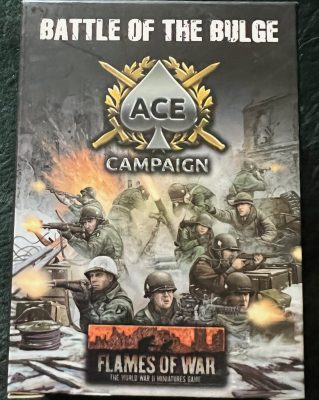
Over the past few years, Battlefront has released several Ace campaign packs. These cover Bloody Omaha, Race for Minsk, and Battle of the Bulge. Each campaign pack retails for approximately $20 and includes a set of playing card sized decks which gives you all you need to run a ladder campaign with missions, rewards, side missions, and a collection of Ace Ability cards.
Recently at D6 Games in Rochester Minnesota, we hosted a Flames of War Late War tournament built around the Battle of the Bulge Aces campaign. This article is going to cover how it worked and served to make the tournament one that will be remembered and talked about for a long time.
For each round of the tournament (there were 3 rounds) we made use of the episodes of the campaign. This set the tone as well as picked the mission and who was attacking. The first episode in the Bulge Aces campaign has the Axis on the attack with Breakthrough as the mission. Further each episode sets forth a set of rewards depending on the outcome. For round one, both players receive a Tier 1 reward.
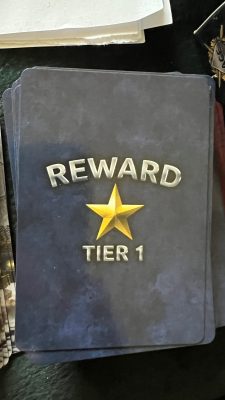
What’s a reward? It’s a random draw from a deck of cards that grants a single-use effect that could be spent in later rounds. Examples would be two to-hit re-rolls from one tank team, or a re-roll for a failed tactics etc. Later rounds would feature higher tier rewards for the winner and lesser tier rewards for the loser of a match.
Since every match was always Axis v Allied, this meant I had to have players commit to one side or the other well before the tournament. We also had several players who were willing to be flexible and bring an army from both sides just in case.
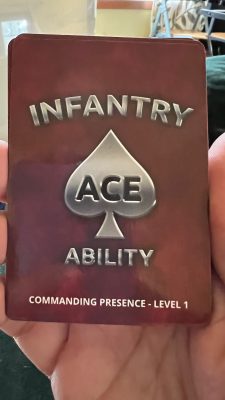
Another aspect of the Ace Campaign we fit into the tournament was the Ability cards. Across each of the three Ace Campaign decks is a set of Ace abilities. These abilities are given to your formation commander. The Ace Abilities are divided between those that apply for infantry as compared to tank commanders. Ace abilities have levels that allows your formation commander to increase their capabilities through successive games. The one catch is your formation commander needs to survive the game. If they were killed, the ace ability drops back down to level 1.
I made a comprehensive list of Ace abilities from all of the Ace campaigns prior to the tournament so that players could build their list and select their Ace ability ahead of time. These were categories like Master of Defense, Expert Engineer, Assault Monster, and so on.
For example, let’s look at Commanding Presence, an Infantry Ace ability. At level 1, this formation commander can hold and contest objectives from 6″ away. At level 2 when a unit leader is within 6″ and line of sight of the Ace, they automatically rally, and at level 3, any units in the aces formation may re-roll a failed Unit Last Stand test.
With six Infantry Ace and six Tank Ace categories to choose from you can imagine this really added significant flavor to the games. Do you risk your formation commander or do you hold back and build them up for a later round? When surviving from round to round matters, players will often adjust their play a bit.

Of course with any tournament you want themed tables, as this was for the Battle of the Bulge snow-covered, winter-themed tables were the rule of the day. Additionally, we keep to a narrower focus for available forces. Russian armies were not in play for this tournament. I feel for those that play Russian armies, I have plenty of Russian lead and enjoy using it, however for this day we kept with the western front.
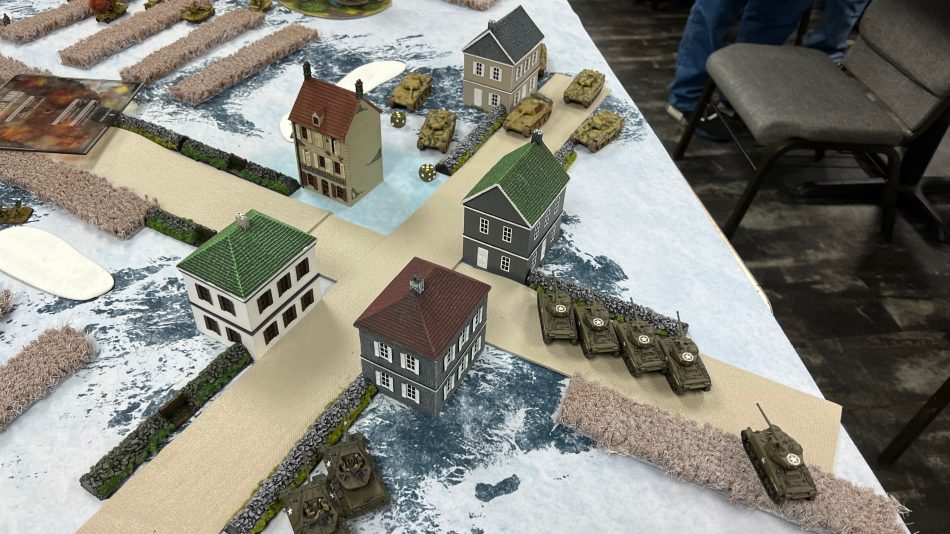
The last major decision I had to factor into the tournament was how to handle the winning, losing, and matching up for further rounds. The Ace campaigns are set up as ladders so winning/losing has an effect on what mission you ultimately will play the next round. The system is wonderfully designed for those situations where you play with someone on a regular basis and thus can have a series of linked actions. In a tournament setting, this isn’t the case, as people are moving around and getting matched up round to round.
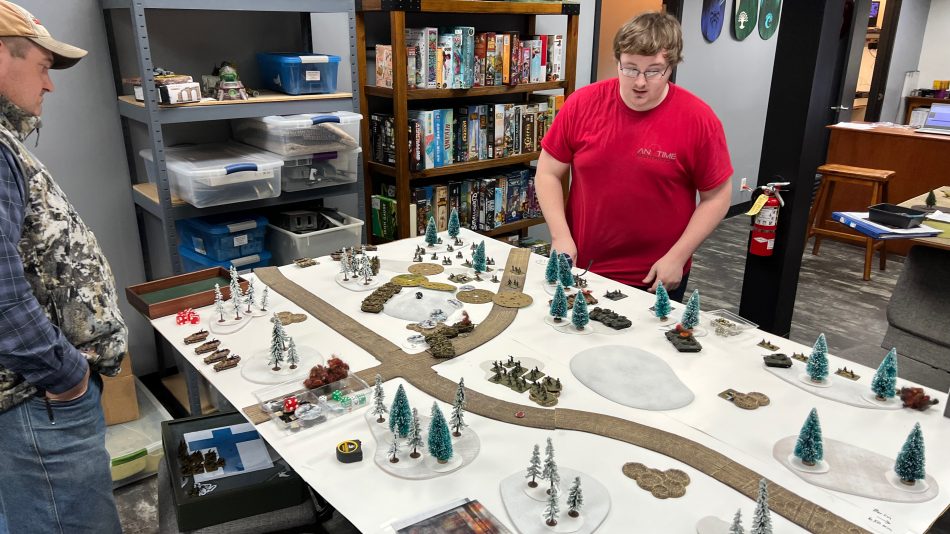
For the first round as the Ace campaign is specific for episode 1, everyone was playing the same mission and with the Germans on the attack. Simple.
With round 2, do we continue to have everyone playing the same mission and thus tally up the wins and losses for all games and the side with a majority of wins makes the call?
Another option was to tailer each matchup, and pair up two people who had each won the prior round but then let points or roll of a die to determine which part of the ladder they’d play.
On the plus side, this meant that people with more victories and tournament points were rewarded by following their storyline in the campaign.
I went with the individual player option, while it was a bit more paperwork it worked well. In the grand scheme, if you look at it as just a method to select a mission for the pairing, and keep it simple as to how you make the match, it is less stress for you as a TO.
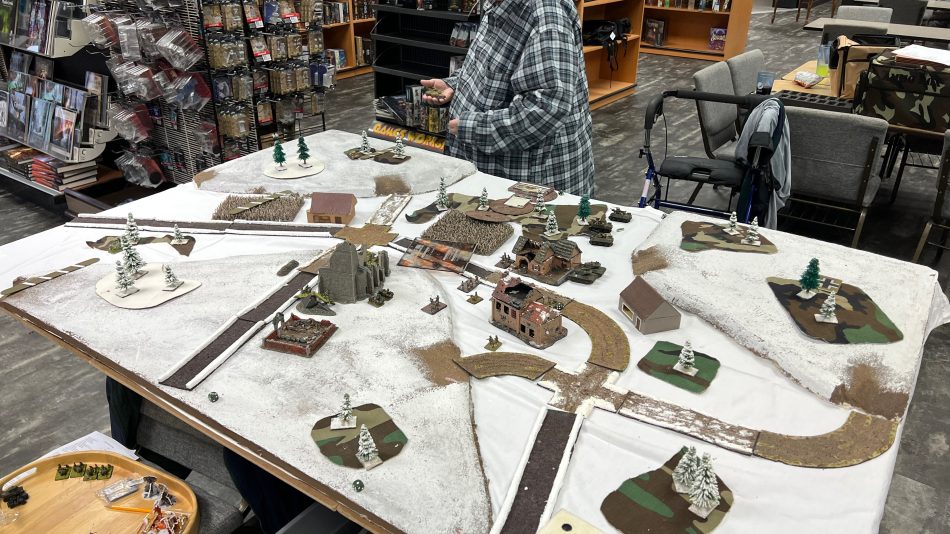
In summary, Ace campaign packs are a fun addition to the tournament scene giving the players a couple of options to amp up their list as the day progresses.
The random draws for reward cards give them the potential for a special situational re-roll. Everyone really liked that. The Ace ability cards made players take a little more care of their commanders in order to reap the later round rewards of a formation commander with more capabilities. While these ability cards and rewards cards might increase the danger of a list or situation getting out of hand, we did not experience that. Most players didn’t put a great deal of thought into their Ace abilities.
While we’ve utilized the Battle of the Bulge Ace campaign, I anticipate we’ll make use of the Race to Minsk Ace campaign at some point. Made for a fun day and an interesting twist on the tournament scene.

Great idea Tom to integrate the Bulge aces campaign aspects into a ditto themed tournament! Makes players going into depth with Aces capabilities and Tier Rewards. Challenging trade offs to be made!